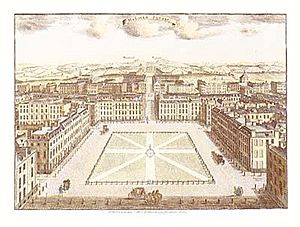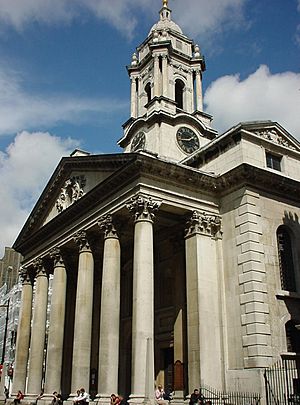William Steuart (British Army officer) facts for kids
Quick facts for kids
William Stewart
|
|
|---|---|
| Born | 1643 Scotland |
| Died | 4 June 1726 (aged 82–83) Hanover Square, London, Middlesex, England |
| Allegiance | |
| Service/ |
|
| Rank | General |
| Commands held | Queen Anne's Forces in Ireland |
| Battles/wars | Williamite War in Ireland |
General Sir William Stewart (1643 – 4 June 1726) was an important Scottish soldier. He became the top commander of Queen Anne's army in Ireland. He was also a Member of Parliament, representing County Waterford, and a Privy Councillor, which meant he advised the King or Queen. Sir William was very generous. He gave the land and helped start the building of St George's, Hanover Square, a famous church in London.
Contents
About William Stewart
William Stewart (sometimes spelled Steuart) was born in Scotland in 1643. His father, Colonel William Stewart, was a soldier who fought for King Charles II. Because of his father's service, William grew up in Ireland, where his family received land.
Joining the Army
William Stewart joined the English Army. He started as a Captain in the 1st Foot Guards. Later, he was promoted to Lieutenant-Colonel by King William III. After the Glorious Revolution, he became a Colonel of the 9th Regiment.
His regiment was part of a group sent to help the city of Derry, which was under attack. The first attempt to help failed. But Stewart's regiment joined a second force that successfully helped Derry.
Fighting in Ireland
Stewart fought bravely in the Williamite War in Ireland. This war was against the Jacobite Irish Army. He was wounded twice during the Siege of Limerick (1690) and also at Athlone. He was hurt badly in his right hand at Limerick, which left him permanently disabled.
Rising Through the Ranks
Stewart continued to be promoted. He became a Brigadier-General in 1694 and a Major-General in 1696. In 1700, he was involved in a duel, where he shot his opponent's hat! By 1703, he was a Lieutenant-General.
In 1711, Queen Anne made him the Commander-in-Chief of her forces in Ireland. This was a very important job. In the same year, he became a full General and a Privy Councillor. Later, King George I removed him from his command of the 9th Foot. This was because the King thought Stewart might be supporting the other side.
Life in London

Sir William Stewart lived in Hanover Square, London. He was also a Member of Parliament for County Waterford from 1703 to 1715. He owned a lot of land in Ireland. After he died, this land was given to his nephews and nieces.
General Stewart passed away on 4 June 1726. He was buried at Westminster Abbey. In his will, he left £5,000 to start a school for poor boys in his London parish, St. George's. He also gave the land for St George's, Hanover Square church and helped lay its first stone in 1721.
Family Life
General Stewart was married twice. His first wife was Lady Katherine FitzGerald. She was already a widow when they married. She died in December 1725. A month later, Stewart married Eliza Alston. Neither of his marriages resulted in him having children.
After making donations to charity, Sir William left most of his money and land to his brother, sister, and the children of his older brother, James. His nephews included:
- Colonel John Steuart, who inherited land in Ireland.
- Major Charles Stewart, who bought Bailieborough Castle.
- James Steuart, who became an Admiral of the Fleet.
Images for kids
-
Sir William Stewart lived in Hanover Square, London.




